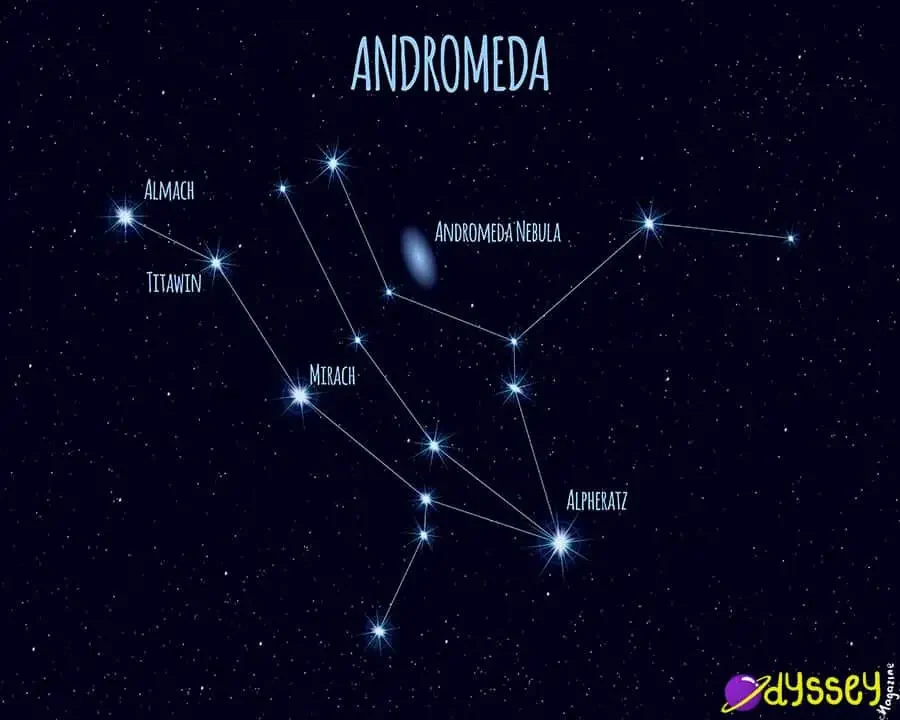Andromeda Constellation | The Chained Woman
If you are looking for one of the most impressive constellations, then Andromeda is a good choice. It is visible for quite a lot of the year, with the best times to see her in the United States being the beginning of Autumn. It has several extremely bright stars to look out for, as well as the infamous Andromeda Galaxy. Lets look at some facts about the Andromeda constellation.
- Bordered By; Perseus, Cassiopeia, Lacerta, Pegasus, Pisces, Triangulum.
- Named after; The Chained Woman
- Declination; +21-53°
- Brightest Star; Alpheratz
- Best seen; Northern Hemisphere, September
- Size rank; 19th
- Constellation family; Perseus
- Pronunciation; VUL-PECK-YOU-LAR

Andromeda takes it’s name from Greek mythology, like many of the constellations in the Perseus family. Andromeda’s mother, Cassiopeia Queen of Ethiopia, bragged about her daughter’s beauty to everyone, including the Sea Nymphs. They encouraged Poseidon (who’s wife was a Sea Nymph), God of the Sea to seek revenge for this – Poseidon summoned Cetus, a sea creature, to attack Ethiopia. Andromeda’s father, Cepheus, intended to sacrifice Andromeda to the creature by chaining her up to a rock, which is where the chained woman or maiden comes from. Fortunately, Andromeda was rescued by Perseus.
Many other people from this story are also constellations. Andromeda is immediately surrounded by her husband, Perseus, as well as her mother, Cassiopeia. Her father, Cepheus, is also a constellation. You can even spot the great sea monster, the Cetus constellation.
We know that Andromeda actually dates back to the Babylonians, however they did not have the name Andromeda and it wasn’t related to the Greek myth. Like many other constellations (there are 48 in total), the first writings that we have of them are from Ptolemy dating back to the 2nd Century
If you’re in the Northern hemisphere, then you should be able to see Andromeda throughout most of the year. The best months to see her are typically September and October.
The Andromeda constellation has many different stars in it, and different nationalities recognize different versions of Andromeda. You can match up the stars with the image of Andromeda below.

- Alpheratz (α) – Alpheratz, or Alpha Andromadae, is the brightest star in this constellation. It is visible without a telescope, and although it may look like a singular star, it is actually two stars together, which we call a binary star system. It is special because one of these stars is the brightest mercury-manganese star in the sky. This star is the head of Andromeda.
- Mirach (β) – Mirach, also referred to as Beta Andromadae, is representative of the body of Andromeda. Mirach is an extremely bright red giant star, with an approximate 1995x luminosity of the Sun.
- Almach (γ) – Gamma Andromedae is another name for Mirach, the third brightest star in Andromeda. It makes up one of the feet of Andromeda. Many people think that Almach is a binary star system, because to look at it, it seems as though it is a blue and yellow star next to each other. In fact, it is a quadruple star system, as it is two sets of stars standing vibrantly next to each other.
- Titawin (υ) – Titawin, also known as Upsilon Andromedae, seems like a simple binary star system made up of a red dwarf star and a larger yellow white one. However what is interesting about Titawin is that we believe there to be four planets actually orbiting this star (a planet in another solar system is called an exoplanet). Astronomers believe these planets to be a similar size to Jupiter.
These are just the main stars in the Andromeda constellation; as you can see, there are more! As well as these stars, we also have the Andromeda Galaxy in this constellation, too.
You’ve probably heard of the Andromeda Galaxy, as it’s suggested that our Milky Way will collide with the Andromeda galaxy in an estimated 4.5 billion years. It is estimated to be 10 billion years old, which makes it more than twice as old as our solar system.
Andromeda is one of the most intriguing constellations, not just for it’s Greek mythology derivation but also for it’s unique stars and the Andromeda galaxy, which our first writings of actually date back more than 1000 years ago.
In certain Novembers’ throughout history, you can actually see a meteor shower (called Andromedids) coming from the Andromeda constellation. This isn’t due again until 2023, however. If you have any more information about Andromeda, please feel free to leave a comment.





